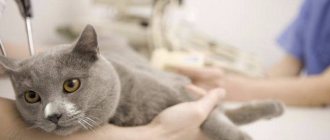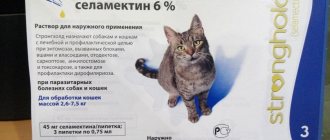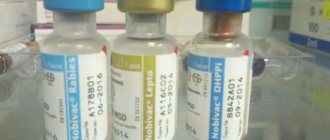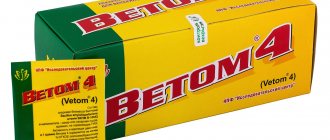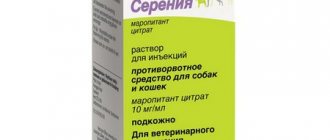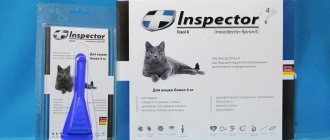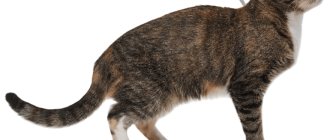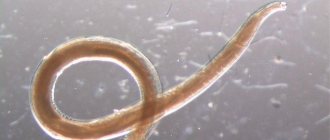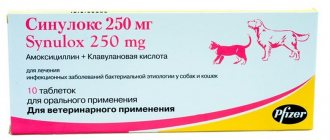Properties, principle of action and indications for use
Baytril for cats
A broad-spectrum antibacterial drug (antibiotic), which is also effective against a number of fungi, is prescribed when the following pathogens are identified in a cat:
- streptococci;
- staphylococci;
- salmonella;
- proteas;
- clostridia;
- Haemophilus influenzae.
The drug is quickly distributed throughout the tissues, providing a therapeutic effect within 20-30 minutes after administration of the drug.
Baytril is active for a day from the moment it enters the body, after which it is excreted in urine and feces. It has been proven that in the tissues of the affected organ the concentration of the drug is significantly higher than in healthy ones.
For cats, an injection solution with a concentration of 2.5% is used.
The main indications for using an antibiotic are:
- diseases leading to inflammation of the respiratory system;
- salmonellosis;
- bacterial lesions of the intestines and stomach;
- inflammatory pathologies of the genitourinary system;
- colibacillosis;
- purulent wounds;
- infections caused by microorganisms sensitive to antibiotics;
- abscesses;
- inflammatory skin lesions.
The drug is prescribed independently or in complex therapy at the discretion of the veterinarian. It is strictly prohibited to use medicine to treat a cat without a prescription, as well as to unauthorizedly change the duration of the course and dosage of the medicine.
For what diseases is it prescribed?
The medication is recommended for the following pathological conditions:
- acute respiratory infections and other diseases of the upper respiratory tract;
- gastrointestinal pathologies caused by bacteria;
- intestinal infections caused by salmonella, streptococci;
- Eschirichiosis;
- after surgical interventions;
- toxic form of sepsis;
- diseases of the urinary system;
- mixed infections.
Injection to a cat
The medication is also prescribed for secondary infection, pustular lesions, purulent tissue inflammation and other pathological conditions that are caused by this provoking agent.
Not prescribed for:
- gestation, feeding newborns;
- under 1 year of age;
- convulsive states;
- diseases of the musculoskeletal system.
Directions for use, dosage for cats
For cats, an injection solution with a concentration of 2.5% is used . The injection is given subcutaneously, less often intramuscularly. The dose of the drug is calculated based on the weight of the four-legged patient from the norm of 0.2 ml per 1 kg of weight.
Be sure to read:
How and when should Lincomycin be used for cats: instructions, dosage and reviews
For a cat whose body weight is less than 1 kg, the individual dose is calculated by a veterinarian. The injection is given once every 24 hours. Course duration is from 3 to 10 days.
If the cat does not get better within 4 days from the start of treatment, testing is required to determine the sensitivity of the pathogen to antibiotics and replacing the medication with a more effective one.
It is unacceptable to violate the treatment regimen. Skipping medication administration or early termination of the course leads to the formation of drug-resistant forms of bacteria. This phenomenon greatly complicates therapy in the future.
Important! Before giving your cat an antibiotic, read the instructions for use!
Baytril reviews
Not everyone who keeps pets evaluates the therapeutic effect of using baytril positively. Some owners complain about the uselessness of the drug, some are concerned about hair loss in their pets and the formation of bald spots at the injection site. Nevertheless, there are still more positive opinions.
# REVIEW 1
Baytril 2.5% was prescribed to us at the veterinary clinic when our female red-eared slider was diagnosed with pneumonia. Five injections had to be made at intervals of 24 hours into the turtle's shoulder muscle. Of course, I could have given the injections myself (especially since they showed me where the required muscle was), but I decided to entrust this to a specialist.
An injection with a Baytril solution in the clinic cost about 54 rubles: this included the cost of the antibiotic itself and a disposable syringe. I saw that the injection was extremely painful from the turtle’s reaction, and then the doctors told me the same thing. They assured me that one of the advantages of Baytril is the absence of side effects, except for possible redness at the injection site and stomach upset.
Our turtle, a few minutes after the injection, had a wonderful appetite, which she demonstrated throughout all five trips to the clinic. Lethargy, one of the indicators of pneumonia, disappeared, and was replaced by cheerfulness and energy. The turtle began to swim with pleasure (as it was before her illness).
A week later, the doctor ordered a repeat x-ray to make sure the Baytril was effective. The picture showed a noticeable improvement, but for now we are taking a break from the injections: we were “prescribed” a two-week vacation, after which we will go to the clinic again.
Now the behavior and appearance of our turtle indicate that she is on the road to recovery, which I see as the merit of baytril. He helped and quite quickly. The course of treatment cost me only 250 rubles, which is quite inexpensive. Our experience of treatment with this antibiotic has proven its effectiveness and the absence of adverse reactions.
# REVIEW 2
Our cat was prescribed Baytril to treat cystitis. A course of five injections into the withers gave absolutely no results. The symptoms (frequent urination, blood in the urine) did not disappear: the cat meowed pitifully in pain, usually before urinating. As soon as they started injecting amoxiclav, there was an immediate improvement.
The consequences of Baytril injections (necrosis of the skin on the withers and a bald spot with a diameter of about 5 cm) were treated for more than a month. The cat experienced incredible discomfort and constantly scratched the area where the hair had fallen out. She recovered in a couple of months, despite the fact that for about a month we applied lotions/powders and various ointments to this area.
I'm not even talking about the pain of the injection itself. After each injection of Baytril, our cat howled and is still terribly afraid of veterinarians. I give this drug a C only because our friends cured their cat with it, however, his fur also fell out at the injection site.
Tags: baytril, baytril, veterinary medicine, animal health, treatment, drugs
Contraindications and possible side effects
There are strict contraindications for the use of the drug in the treatment of cats. Their compliance is mandatory.
It is unacceptable to use the composition in the following cases:
- pathologies of the nervous system of varying severity;
- convulsive conditions;
- individual intolerance to the drug;
- pathology of cartilage tissue;
- bearing kittens;
- feeding kittens.
Also, the medicine is not used if the bacteria that caused the pathology are resistant to the active ingredient Baytril.
There are strict contraindications for the use of the drug in the treatment of cats.
Side effects may sometimes occur while using the drug. If they occur, you must immediately notify your veterinarian.
At the discretion of the specialist, the medicine will be replaced with an analogue or treatment will continue with Baytril, but in parallel, additional drugs will be prescribed that will relieve side effects.
Possible negative consequences from taking the medicine are as follows:
- vomit;
- diarrhea;
- lack of coordination;
- behavior change;
- severe weakness;
- loss of appetite;
- skin itching.
To improve the pet's condition, he is given antiallergic drugs even before visiting the veterinarian.
Interaction with other drugs
Not prescribed while taking the following medications:
- Theophylline;
- Non-steroidal anti-inflammatory drugs.
Combination with chloramphenicol, chloramphenicol, tetracycline antibiotics, as well as simultaneous use with medications that contain aluminum and magnesium are not recommended.
With a wound
Composition and release form
The drug is produced in the form of a solution for administration by injection. The liquid is colorless, transparent. It is packaged in glass bottles.
The main active ingredient in the antibiotic is enrofloxacin. The antibiotic belongs to the group of fluoroquinolones. Excipients in the composition are water for injection, butyl alcohol and potassium oxide hydrate.
Be sure to read:
Prednisolone for cats: indications, dosage, instructions for use for different forms
CONFIRMATION OF THE EFFECTIVENESS OF BAYTRIL IN SMALL ANIMALS
Dogs: Clinical effectiveness has been established in skin infections (wounds and abscesses) associated with susceptible strains of Escherichia coli, Klebsiella pneumoniae, Proteus mirabilis and Staphylococcus intermedia; respiratory infections (pneumonia, tonsillitis, rhinitis) associated with susceptible strains of Escherichia coli and Staphylococcus aureus; and urinary cystitis associated with susceptible strains of Escherichia coli, Proteus mirabilis, and Staphylococcus aureus.
Palatability: free choice flavors Baytril Taste Tabs
were confirmed in a study in which 350 individual dosages resulted in voluntary consumption of 73%.
Cats: Clinical effectiveness has been established for skin infections (wounds and abscesses) associated with susceptible strains of Pasteurella multocida, Staphylococcus aureus and Staphylococcus epidermidis.
Cost and analogues of the antibiotic Baytril
An injection solution with a concentration of 2.5% in 100 ml packaging costs an average of 350 rubles. You do not need a veterinarian's prescription to purchase.
If necessary, replace Baytril with an analogue, the following drugs can be used:
- Enromag;
- Ciprofloxacin;
- Quinokol;
- Enrosept;
- Enroflox.
Also, if for some reason it is not possible to purchase a veterinary drug, it can be replaced with the drug Tsiprolet from a regular pharmacy. It is important to consult your veterinarian regarding dosage in advance.
Appointments
The medication is indicated for the treatment of skin diseases or is prescribed in the postoperative period to maintain the body.
For kittens and older cats, “Baytril” is indicated for use in pathologies that are associated with the pet’s respiratory system, ailments of the skin and digestive system. The drug is actively used in veterinary medicine for urolithiasis and the presence of bacteriosis caused by Escherichia coli. In addition, Baytril can be prescribed to kittens as a supportive agent during surgery and during the rehabilitation period. An antibiotic is often prescribed for recurrent infections, abscesses and purulent inflammations.
Storage features and safety measures
Also, if for some reason it is not possible to purchase a veterinary medicine, it can be replaced.
Store the medicine at room temperature in a place protected from light. The sealed product is good for 3 years. Opened antibiotic packaging is stored for no more than 28 days. After the expiration date, the drug should not be used.
Medicine bottles cannot be used for household purposes. They should be disposed of with household waste. Do not eat, drink or smoke while working with the medicine. If the composition gets on the skin or mucous membranes, rinse them immediately with plenty of clean water.
Warnings
Baytril is for use in animals only. In rare cases, use of this product in cats has been associated with retinal damage. Do not exceed 5 mg/kg body weight per day in cats. The safety of Baytril in breeding or pregnant cats has not been established. According to the instructions for use, keep out of the reach of children.
Avoid contact of Baytril solution with eyes. If contact occurs, immediately flush eyes with plenty of water for 15 minutes. In case of contact with skin, wash skin with soap and water. Consult a physician if irritation persists after exposure to eyes or skin. People with a history of hypersensitivity to quinolones should avoid contact with this product. People are at risk of photosensitivity within a few hours of excessive exposure to quinolones. In case of excessive accidental exposure, avoid direct sunlight.
Where can I buy?
First of all, you can buy Baytril in veterinary pharmacies. There it is found under its original name. It can be found in ampoules and vials with injection solutions. Additionally, there is a preparation for oral use, which is mixed with water for animals and is most often used in poultry (geese, chickens, ducks and others).
If you don’t find it in a veterinary pharmacy in your locality, you can go to a regular one. There you can buy the antibiotic Ciprolet or another drug based on ciprofloxacin. It is sold in ampoules and tablets.
In the latter case, it is worth getting additional advice from a veterinarian so as not to exceed the dose. The tablets are placed on the base of the tongue, and in order for the animal to swallow them, you need to lightly stroke the neck from the mouth down.
Read more: melarsomin, butox.
